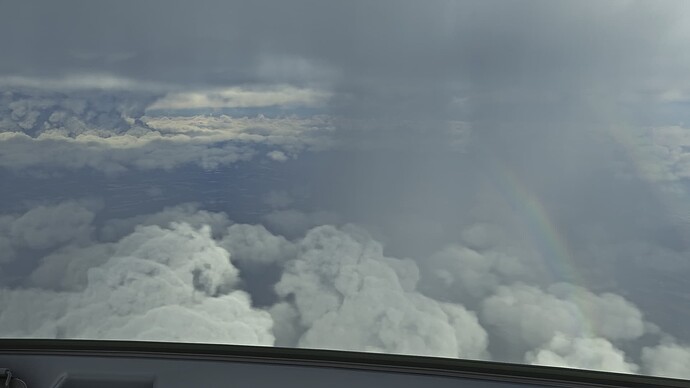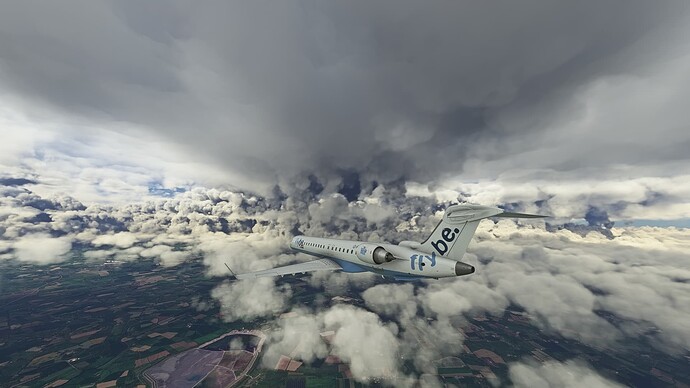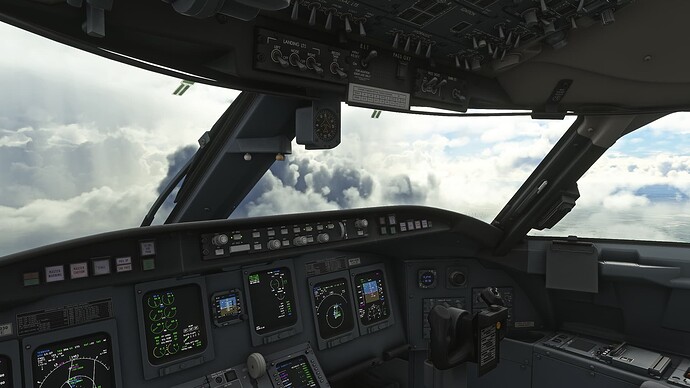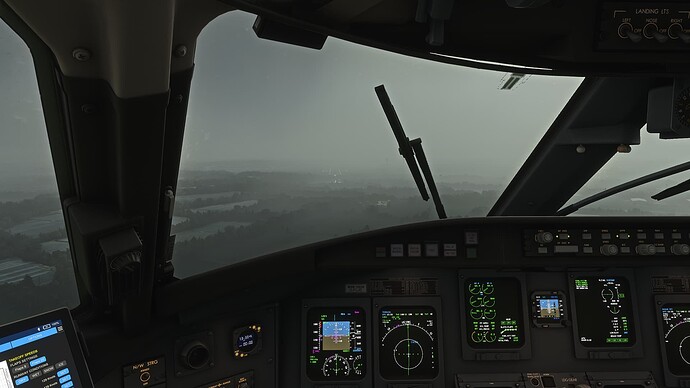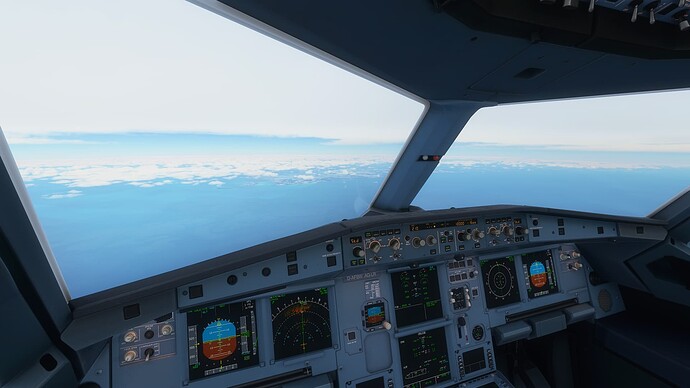Just. Amazed.
Stunning!
But wait we had that before plus proper overcast. No harsh transitions back then either.
Just going through my screenshot folder reminiscing about old times.
that’s a full cover layer, I was talking about it attempting to reproduce the wispy cirrus clouds
oh man thats nice. Its like everyone forgets what it used to look like. I have 100s of pictures of live weather that could never be reproduced given the current weather engine.
Oh, don’t start. ![]()
And we also had often completely inaccurate weather at airports. Pretty, maybe… but operationally unfunctional for folks trying to use the simulator as a simulator.
And of course, the weather is not just occasionally depicted correctly by “random chance.” That’s basically impossible, and that was my point. When the weather is depicted correctly - as it seems to be more and more frequently, and as it was in my original post - it’s NOT random chance, it’s the result of the weather engine performing correctly.
It’s the result of many more reasons than just pressure gradient boundaries. There are temp boundaries (fronts), lapse rate boundaries (stable vs unstable atmosphere dictating many things from clouds appearance to precip type) etc. Then there are microscale effects that can, for example, create fog in one valley but not the next… or an outflow boundary or rear-flank downdraft from convection that can dramatically affect conditions within 20 miles or so…I mean there’s dozens of these things. They cannot be accurately modeled, which is one reason of many why an hours-old model run is incapable of producing accurate local weather.
Transitions can and do occur abruptly; which is why a type of Metar report (the Speci) exists to keep reported weather conditions up to date at airports.
Well i can’t see any kind of transition in this timelapse. The weather changing all the time and it’s always smooth without transitions between sources.
Not like this transition.
This is what happens if one METAR says scattered/broken and then next says OVC rain with low visibility if we need them to match 100% all the time. Same thing with the wind. Sudden change in windspeed. Same thing with visibility. Weather is a global thing not a local thing. This is a transition into weather 24 hours later though but it’s the same thing actually if the weather has changed fast with a speci. The more speci updates the more sudden changes we will see.
Here is some time lapses someone posted here in the forum at release in Octoboer 2020. I can’t se any kind of sudden transitions in those. Look at the john f kennedy video when the fog comes over the airport. Can never have it like that now because the weather needs to match those METAR now. We have different opinions but i preffer this. Nobody can change my opinion.
This particular sentence/statement lies at the core of the problem, that we have today with msfs’ weather development in my opinion.
Weather pre-SU5 (can’t really remember the version) was mainly based on a forecasted and predicted weather model by Meteoblue, thus building a globally dynamic and fluid weather system (how much of any METAR data has been blended into this initial phase, I can’t say, but it wasn’t very prominent from what I can tell).
The result of this approach (the most advanced approach of any flight sim if you ask me) were hordes of people comparing the predicted forecasted weather model to measurements of weather reporting stations across the globe that people accessed through real life (aviation) weather services.
This lead to increasing numbers of people complaining about inaccurate, unreal, unrealistic, broken etc. weather in the simulator relative to what those people saw the real life weather stations were reporting.
I think what people get “wrong” is the small but important difference between “real” and “realistic” weather.
With the forecasted predicted weather model from Meteoblue we got the most “realistic” weather a flight sim ever had. It didn’t need any refreshes, it was global, it was fluid, it was dynamic, it was influenced by a myriad of factors (coming from Meteoblue) etc. Realistic in the sense of plausible, to use another word. The weather engine didn’t produce any weather phenomenon that could not exist for a certain part of the world for a certain season and it didn’t produce any extra-terristrial weather phenomenon. It was realistic/plausible and it became increasingly bettter at doing so.
But people compared the weather to the metar and weather station reports of the real world, at airport X at time Y and any observed discrepancy was used to critize the forecasted approach. Because it wasn’t “real” or “live”.
So several things are at play here:
- People’s weird conception of real vs. realistic weather.
- Asobo’s or MS’ choice to call it live weather and the (completely unrealistic) expectations people got from it
- People’s obsession with that the in-sim weather needed to exactly (and by exactly I mean down to the single digit) match that of some real world place X and time Y.
The METAR approach is basically trying to adress exactly that and it produces problems, because now we have static, locally limited weather data that needs blending with the fluid and global weather data from meteoblue’s forecasted weather model. This in alone is a problem and I don’t need to repeat all the other problems that comes with such an approach, let alone that we are back at a weather system which underlying technicalities haven’t changed since years of flight sims and who wants to go back to those?
And just to be clear: Of course, the initial weather approach had its problems, but it got better and better. Once the major bugs were/are solved, I didn’t experience weather that was 180° off from what the metar reports actually reported (even without metar based data injection). People used live weather from the get go on VATSIM without huge problems. Sure, the wind direction maybe didn’t match the used metar report exactly, but it was close enough to be used.
I think it’s a shame we are seemingly going backwards towards METAR based weather depiction and I really hope Asobo can come up with a way that puts the overal weather fidelity back to pre-SU5 (again, not entirely sure on the version but it doesn’t really matter) standards.
Also, because for the people wanting METAR based weather, there is a freeware and payware mod from pretty much the start of the sim, and yet everybody is now forced to use this outdated method.
My 2 cents.
EDIT:
I completely forgot one point: The in-sim metar report.
It would have been so perfect (and still would be I guess) to have a reliable in-game metar report that reports the in-game weather in metar format for the people to use those reportings for their flight planning. That would take out the urge to consult real life weather reporting stations for flight planning and thus making discrepancies between real life and in-sim weather less of a factor for flight planning in the simulator which arguably lead to a lot of confusion and frustration.
It’s sad they made the statement that METAR will not get a toggle to turn it off. It only make it enjoyable for those that asked for METAR. We that do not like it and do not see potential in it will remain dissapointed by this choice they made. Agree with everything you said  Thats my opinion as well.
Thats my opinion as well.
I agree with everyone here except for one caveat: The Metoblue forecast was not predictable in the sim. For example, I could pull up the Meteoblue forecast, plan my flight, but the weather in the sim would be completely different. So, there was an issue with Asobo’s implementation of the Meteoblue data, and there still is.
The flight planning factor is a huge part of the fun in a flight simulator. Unfortunately, this was never really possible with the previous Meteoblue implementation.
Now, if my LittleNavMap icons show IFR conditions at the airport, this will likely be the case. If it shows clear skies, it will be close in the sim. Not perfect, but usually good enough.
It has made a difference To ME. That’s all I can really say.
Have you talked to a vatsim controller about this statement? ![]()
Have you read my OP, looked at the screenshots or watched the video? The entire point of this post is that the current live weather system, of model data blended with real data, is now achieving this level as well, and getting better at it. Everything in my OP shows this; you can’t just ignore that. This is what I mean about people sticking to a narrative. The whole purpose of this post is to show that we CAN have accurate weather that is also pretty; it’s not an either/or proposition.
We have Metar reports for in-sim wx… but this has been covered before, it’s not a solution. MSFS is supposedly a simulation, not a game, and many people want to use their real life flight planning tools with it for proficiency. There’s no way to tell Foreflight to use MSFS make-believe weather.
Haha I could show you some videos around supercells…
But yes I know what you’re saying; the harsh popping into the sim of new weather. I agree that needs to be fixed, but that was one of the points of my OP - it clearly IS being fixed. This was a pretty complex day, weather-wise. And yet, I flew through not a single harsh transition, even though I saw many different types of conditions on my flight. The video showing the breakout is an example of this. So, not only does this prove it’s possible, but it proves that changes are being made. I’ve flown several more IFR flights through changing conditions since then, and haven’t seen popping weather or harsh transitions once.
It’s a fallacy to claim that Metar integration necessitates popping weather transitions. The evidence indicates this is not true.
Nice reframing there but we’re not asking for pretty, we’re asking for real. Something we had more of before, and less of now.
I’m happy for you that gets the weather as you like. I know that my point of view will not change anything. Because using only prediction as weather is automatically unrealistic because it’s not matching real world weather 100%.
Explain this statement to me, in the context of using real-world flight planning and navigation tools. If you had “real” weather before, can you explain why these tools did not work with the sim before?
I’m not a fan of this METAR change, but I also think there’s nothing wrong with blending METAR data with other types of data when done right. Meteoblue’s nowcast does this extremely well, but the only reason it does it well is because they have a massive amount of historical and future data that the system uses for temporal and spacial blending and their atmospheric simulation. METAR basically nudges their system in the right direction without creating rough transitions and is used as historical data to tune the forecast system. This brings me to the point… The only reason they do it well is because they store a ton of data and they are dedicated to doing it well since that’s their entire business. Unless Asobo is willing to store that amount of data and invest that kind of dedication into their weather engine, I don’t see it being feasible for them to smoothly blend between METAR and Meteoblue, especially with the current system where it seems to include some client-side blending (someone feel free to correct me here).
No, you’re asking to move back to ‘accurately depict local, but not global, current conditions’. I’m questioning you saying people want ‘pretty’. I think people want real, which also naturally includes ugly overcast etc.
It absolutely does not mean endless popcorn clouds which is what the hopelessly restrictive metar reports often give us now, and very few other cloud types.
By “pretty” I mean visually appealing, and the mindset that this should take precedence over accuracy. The entire point of my post is that this mindset that it cannot be accomplished with Metar blending is demonstrably false. You can see, in the evidence I posted, that there is overcast. There are no popcorn clouds. There are no harsh transitions. Etc.
It can be accomplished, and it is being accomplished… AND the weather is accurate now too.
Does that mean it works correctly every time? Nope, but it is improving in my experience and that of many others. This does not mean that they shouldn’t continue to improve it further.
But it DOES mean that this narrative that weather can never be visually appealing with smooth transitions because of metar integration is entirely false. This post is literal proof that it’s perfectly achievable, in challenging conditions.
Why would someone not want both visually appealing, and accurate, weather?
I see what you’re saying, and that has been the concern. It’s the concern that prompted me to make this post. My OP shows conclusively that it actually IS feasible to accomplish this, in challenging conditions.
